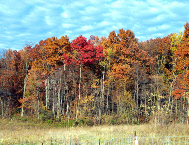
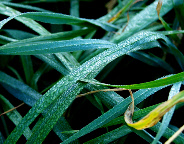
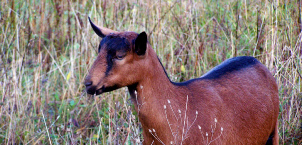
Feeding Goats
The Digestive System
Goats are ruminants, meaning that they have four stomach chambers, like cows. Goats don’t have any upper incisors or canine teeth. While goats can hold around 12 gallons in their digestive system, humans can only hold about 2 gallons. The rumen contains many microorganisms which break down foods and synthesize nutrients. When goats chew their cud, they are rechewing food they swallowed earlier. The cud is also called a bolus. A goat can spend 8 hours every day chewing their cud.
A baby goat has an abomasum which is larger than all the other stomach chambers. The rumen and the reticulum take up 30% of a kid’s stomach, while the rumen takes up 80% in a doe. When the kid drinks milk, it flows directly to the abomasum where it is digested. The rumen enlarges when the kid nibbles at hay and grain.
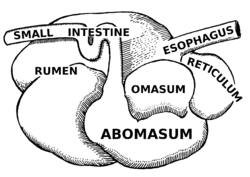
Functions of the four stomach chambers:
- Rumen: Also called the fermentation vat. Micro-
organisms, such as bacteria and fungi, supply enzymes to break down fiber and convert cellulose into volatile fatty acids, which provides up to 75% of the goat’s energy needs. Microbes also produce protein from simple nitrogen compounds in the feed, as well as manufacture amino acids and all the vitamin K and B- vitamins a goat needs. - Reticulum: also called the honeycomb. It is separated from the rumen by a partial wall. The reticulum functions as a fluid pump. Odd materials that a goat happens to pick up remains here, unless it is sharp or pointed. Then it can work its way through the reticulum wall causing serious damage and requiring surgery.
- Omasum: has of folds of tissue for increased surface area and better absorption.
- Abomasum: This is the second largest chamber and is the true stomach, where the actual digestion takes place. It contains hydrochloric acid and pepsin enzymes that breaks down protein into easily digestible simple compounds.
Proteins
Most animal nutritionists agree that 14-
Roughage
Roughage includes green, growing plants,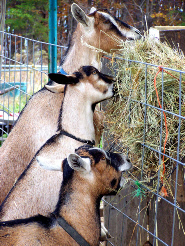 trees, shrubs, and hay. Roughage
provides fiber which is needed for good rumen action and normal milk production.
There are two types of hay: legume hay and carbonaceous hays. Legume hay is made
from alfalfa or clove and carbonaceous hays (grass hay) are made form timothy or
brome. It is very important to balance Calcium and Phosphorus. Alfalfa hay
is high in Calcium and low in Phosphorus, while grass hay is high in Phosphorus.
Silage, haulage, sunflower, root crops such as turnips, carrots and beets are also
roughages.
trees, shrubs, and hay. Roughage
provides fiber which is needed for good rumen action and normal milk production.
There are two types of hay: legume hay and carbonaceous hays. Legume hay is made
from alfalfa or clove and carbonaceous hays (grass hay) are made form timothy or
brome. It is very important to balance Calcium and Phosphorus. Alfalfa hay
is high in Calcium and low in Phosphorus, while grass hay is high in Phosphorus.
Silage, haulage, sunflower, root crops such as turnips, carrots and beets are also
roughages.
Hays are legumes or grasses cut an early growth and sun-
Concentrates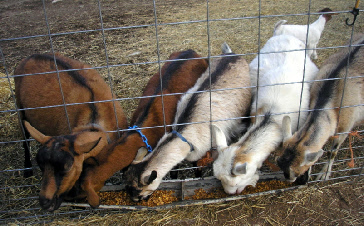
Milking does should receive about ½ pound of grain for every pound of milk they produce. Concentrates are primarily mixed from a diverse range of grains. The feed should not be dusty or finely ground.
Goats are creatures of habit and are easily upset by changes in their routine. Goat’s rations should be split in two and fed two to three times a day. They should be fed so that each goat gets their fair share and no more. Overeating grains causes rapid fermentation in the rumen leading to bloat.
For pregnant goats, you should slowly increase the grain ration during their last two months of gestation.
Nutritional Requirements
All goats have certain nutrient requirements to keep their health, and produce efficiently. Goats need relatively large amounts of calcium, phosphorus, magnesium, sodium, chlorine, potassium and sulfur.
- CALCIUM-
Calcium is necessary for growth, teeth, and bone development. Milk is very high in calcium so dairy goats need more than goats raised for meat or hair. Feed- grade limestone and alfalfa is a good source of Calcium. Calcium also maintains the heart muscles. Signs of deficiency are decreased milk production in lactating does and abnormal bone development in young kids. - PHOSPHORUS-
Phosphorus is essential for sound bones and teeth. It is also needed for tissue growth. The calcium to phosphorus ratio should not drop below 2:1. Signs of deficiency are slowed growth and unthrifty appearance. Silage usually contains enough phosphorus. - MAGNESIUM-
Magnesium is needed for the nervous system to properly function. It is closely related to the metabolism of Calcium and Phosphorus. When goats graze lush pasture, magnesium deficiency may occur. Symptoms are loss of appetite and excitability. - SALT (NaCl)-
Salt is sodium chloride, and is sufficient to provide for both minerals. Salt should be available at all times in loose form since goats cannot lick enough salt off a salt block. Symptoms are loss of appetite, consumption of soil, rough appearance and lusterless eyes. Salt would become toxic if around 9.0% is consumed. - SODIUM BICARBONATE-
This also known as baking soda. It is necessary to maintain a correct rumen ph for maximum absorption of essential nutrients. Baking Soda should be available on a free- choice basis. - POTASSIUM-
Potassium (K) is needed in large amounts. Deficiencies usually occur when goats consume high concentration rations. Goats eat less and produce less when deficiencies occur , and severe deficiencies can cause emaciation. - SULFUR-
Sulfur (S) is particularly high in in the composition of goat hair. Lack of sufficient sulfur causes salivation, tearing at hair and loss of mohair. Angoras will need more sulfur because of mohair production. - IODINE-
The trace mineral iodine is necessary to prevent goiter, the swelling of the thyroid gland. Iodized salt is necessary to prevent deficiency. Symptoms of iodine deficiency are goiter or kids born weak or dead. - SELENIUM-
Selenium is needed in tiny amounts to protect against oxidation of fatty acids and the resultant tissue damage. Selenium deficiency can cause White Muscle Disease. Toxicity is very common when goats consume plants containing too much selenium from the soil over an extended period of time.
Vitamins
Vitamins are needed for maintaining a normal state of health in goats. Most goats can get all the vitamins they need from browse and foraging. Stall housed goats, high producing goats, and kids may need additional vitamins.
- VITAMIN A-
Vitamin A is needed for tissue growth, good reproductive abilities and resistance to diseases. Deficiency usually occurs during droughts when forage is limited. Symptoms are respiratory problems, multiple infections, and visual impairment. Vitamin A can be given as an addition to feed. - VITAMIN D-
Vitamin D is needed for the proper absorption of calcium and phosphorus. Usually all goats need is plenty of sunshine. - VITAMIN E-
Vitamin e is important to milk quality, and aids in milk storage in the udder. When soils are very low in selenium, Vitamin E deficiencies may occur. Signs are not very notable as milk production rarely decreases.
Another very important nutritional factor is water. Water is essential for all
metabolic processes. Goats should have free-
How I feed my goats:
Basically I estimate the weight of my goats. Maintenance is about 2% bodyweight.
So a 100 lb doe should eat 2% DM. I don’t feed more than half their diet in concentrates.
In the last month of gestation, does eat about 3% and then 4-
During the summer, I average about ½ lb of grain per doe then free choice grass.
When there is no pasture available, they receive a grass mix hay. They build up
to 1-